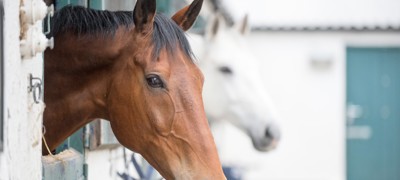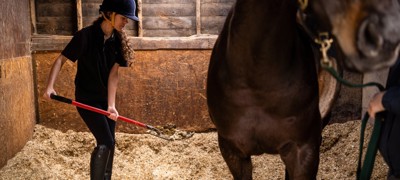What you’re required to do by law
The Regulatory Reform (Fire Safety) Order 2005 is the fire safety legislation that applies to all animal premises. This includes stables where people work, livery stables, equestrian centres and private establishments that employ staff.
If you are a business owner or employer, you are the responsible person and you must carry out and record a Fire Risk Assessment of the premises. This will identify what you need to do to prevent fire and keep people safe. Your Fire Risk Assessment should be reviewed yearly or if there are any significant changes to the property or staff that could affect fire safety.
If you need more information about fire safety, contact your local Fire and Rescue Service or visit the Fire safety: guidance for those with legal duties - GOV.UK (www.gov.uk)
Help with Fire Risk Assessments
To find out more about fire risk assessments and what you have to do for each of the steps on the next page, visit the following websites:
Or you can buy copies of the guides in bookshops.
You can carry out the Fire Risk Assessment yourself with this guidance, however if you do not feel comfortable doing so you can employ a Fire Risk Assessor to do this for you. Ensure the person you employ is competent and registered or certified with a professional fire safety body.
A Guide to Choosing a Competent Fire Risk Assessor (london-fire.gov.uk)
The three main professional bodies that have a registration scheme are the IFPO, IFSM and the IFE.
Risk assessment
These five steps are examples of what you could consider for your Fire Risk Assessment
Step 1: Identify any hazards, including:
chevron-down
chevron-up
- Sources of ignition – these could include things like farm machinery, tractors and quad bikes, damp hay (spontaneous combustion), naked flames, faulty or dangerous electrics, especially circuits that have been added to and smoking.
- Sources of fuel – this is anything that could burn, such as hay, straw, gas cylinders (LPG), petrol and diesel.
- Dangerous substances – these could be chemicals, fertilisers, poisons, asbestos and so on.
Step 2: Identify any people at risk, including:
chevron-down
chevron-up
- Anyone near your Equestrian buildings including the public.
- People who work for you or who are on your premises.
- Young people.
- Firefighters and other emergency service personnel responding to a fire.
Step 3: Evaluate, remove, reduce and protect from risk
chevron-down
chevron-up
- Evaluate the risk of fire occurring.
- Evaluate the risk to people from fire.
- Evaluate the risk to animals from fire.
- Remove or reduce any fire hazards.
- Protect people and your property from fire by installing appropriate detection, firefighting equipment, lighting, provide signs and notices and keep escape routes clear.
- Carry out regular maintenance on electrics and equipment.
Step 4: Record, plan, inform, instruct and train
chevron-down
chevron-up
- Record any significant findings and the action you have taken.
- Prepare an emergency plan.
- Inform and instruct anyone who might be affected.
- Provide training on firefighting equipment and regularly practice your evacuation plan.
Step 5: Review
chevron-down
chevron-up
- Review your fire risk assessment at least once a year and when changes happen that could affect fire safety.
Arson reduction checklist
Arson in rural communities is a real risk, nearly half of all rural fires are set deliberately. As part of your fire risk assessment, you should do a survey of your equestrian buildings and identify any areas that are at particular risk from arson. The outcomes of this arson checklist should be included in the overall fire risk assessment and action plan for the stables.
Signal Crime
chevron-down
chevron-up
- Is there a history of vandalism or fire setting in the area around the stables?
- Is trespass a problem?
Storage
chevron-down
chevron-up
1. Is hay and straw kept separate from the stables?
2. Is bedding kept separate? i.e. shavings etc
3. Is hay and straw stored in stacks of a reasonable size and spaced at least 10 metres apart?
4. Is the muck heap situated away from the stable yard?
5. Are petrol, diesel and other fuels stored in secure areas?
6. Are horseboxes and trailers stored securely away from buildings?
7. Are fertilisers and pesticides kept under lock and key?
Security
chevron-down
chevron-up
1. Is the security of all equestrian buildings maintained at all times?
2. Is security lighting provided?
3. Are the buildings fitted with a fully operational intruder alarm with a monitored link to an alarm receiving station?
Fire Safety Management
chevron-down
chevron-up
1. Are all unoccupied areas regularly checked to ensure they are safe and secure and that there is no unnecessary accumulation of combustible materials?
2. Is all refuse disposed of safely and on a regular basis?
Dangerous substances
Under Chemical Regulations you must tell people on your farm, include workers, firefighters and other emergency services personnel, if there is a possibility that dangerous substances are involved in a fire.
They will need to know the location of any:
- Bottled gas, especially acetylene and LPG, and bulk diesel or petrol.
- Asbestos in the materials the buildings are made of.
- Ammonium nitrate fertilisers or any other agrochemicals and poisons.
- Consider installing a Fire Box at the entrance to your property, this should include
- information such as a map of the land indicating:
- Location of water supplies (hydrants/open water)
- Location of stables and evacuation paddocks
- Hazardous materials storage
- The owner or managers contact details
Fire precautions
- Have an evacuation plan that is well rehearsed and known by all the people who use the stables.
- Have firefighting equipment on the stable yard and keep it regularly maintained. Ensure your hose reaches the full length of your stable yard. It may help to reduce fire spread for evacuation purposes. Remember to only use firefighting equipment if safe to do so.
- Ensure all combustible materials are stored well away from the stables including bedding, feed, hay, straw and husbandry items like rugs etc.
- Ensure gangways and escape routes are kept clear of hay, straw, haynets and rugs. For internal barns always have an alternative escape route, ideally one at each end.
- Ensure the muck heap is located downwind at least 15 metres from your stables.
- Park vehicles well away from buildings in a secure area.
- Designate a smoking area away from the stables or preferably do not allow smoking at all.
- Ensure your electrics are tested at least once a year by a qualified electrician.
- Install robust security measures to prevent theft and arson.
- Switch off tack room/communal area heaters when not in use.Do not leave them on overnight unless they are designed to do so.
- Never stable animals in barns alongside hay, straw and vehicles.
- Fit fire detection in stables if necessary. Hard wired optical or heat detectors are best, remote sounders are available if the alarm will distress the horses.
- Stables of brick construction with tiled roofs behave better in a fire situation. Wood and felt/corrugated roofing burns and deforms quickly. These may be cheaper and water resistant but they do not behave well in fire, often melting and causing burns to the animals. Nylon rugs will melt and burn the horse’s skin, consider using old jute style rugs.
- Invite your local fire rescue crew to come and familiarise themselves with your layout, water supplies, animals and evacuation procedure.
Fire evacuation guidelines
Signpost or number your evacuation paddock gates. Enter this onto the fire plan in your ref fire box. If needed, specify which stables need to be evacuated in to which paddock.
Try to locate your evacuation paddocks up-wind of your stables.
Always number your stables and have head collars available outside in case of evacuation.
In case of stallions, injured animals or broodmares etc. identify their stable number and indicate on the evacuation map which paddocks/area these need to be evacuated to.
In case of evacuation
Always start with the horses closest to the fire.
Close the stable door after you have removed the horse, loose horses will return to a burning stable!
Always try to place horses in a secure area. Loose horses are dangerous and could hamper firefighter’s efforts to access and extinguish the fire.
If a fire breaks out
- Call the Fire and Rescue Service immediately.
- Tell the operator:
- Where the fire is – give the full postal address including the postcode. You can also give a 3 word address to share a very precise location using the free what3words app.
- Exactly what is involved – especially if any animals or chemicals are involved or likely to be involved in the fire.
- If the access to the fire site will be difficult for the fire engines.
- If there will be problems accessing water supplies on site.
- Never attempt to fight the fire unless it is safe to do so.
- If possible send someone to the entrance to direct the Fire and Rescue Service to the fire. Ideally they should be wearing high visibility clothing and have a torch if it is dark, so they are easy to be seen.
- Clear access routes to the fire site for the fire engines.
- Follow your evacuation guidelines if necessary or be prepared to move the animals in case the fire spreads.
- Make yourself known to the Fire Crew on arrival and answer any questions they may have
Controlled burning
If you are doing any kind of controlled burning such as burning rubbish, please contact your Fire and Rescue Service to inform them and save an unnecessary call outs.


